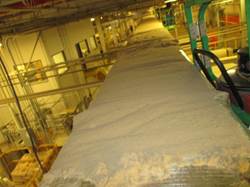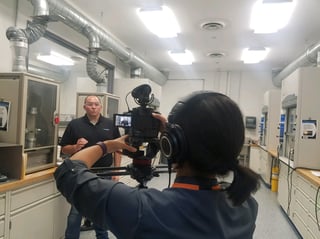Combustible Dust Hazard Assessment (DHA) or Dust Hazards Analysis
You've been dabbling in dust. You've googled it. You know there's NFPA 652, 654 and some other regulations about it out there... but still, you aren't sure what to do next. Do you need a test? Does your boss need convincing? What makes up a Combustible Dust Hazard Assessment/Analysis (DHA) anyway?
Combustible Dust Hazards are a concern for every industry and plant - in particular, pharmaceutical, food/agriculture,  plastics/polymers, metal, wood, cosmetic, and manufacturing. Simple Go/No-Go tests are inexpensive and can help save a lot of time and heartache in terms of purchasing the right equipment, making sure your equipment is performing as it should and most importantly, protecting your employees as well as your facility. You can meet code and stay ahead of the game with a few simple steps to test potentially hazardous combustible dust.
plastics/polymers, metal, wood, cosmetic, and manufacturing. Simple Go/No-Go tests are inexpensive and can help save a lot of time and heartache in terms of purchasing the right equipment, making sure your equipment is performing as it should and most importantly, protecting your employees as well as your facility. You can meet code and stay ahead of the game with a few simple steps to test potentially hazardous combustible dust.
A Combustible Dust Hazard Analysis or Assessment (DHA) is a comprehensive look at your dust within the complete framework of your workplace and its operations and equipment. Look for a testing lab that offers a wide range of services related to Dust Hazards Analysis (DHA) including characterizing, preventing and mitigating combustible dust explosions and fire hazards. These services include combustible dust testing, onsite assessments, OSHA and NFPA compliance assistance, audit preparation, training, ignition source evaluation and vent sizing calculations. Seek an ISO17025 accredited lab that has been in the testing and consulting business for many years. Reputations mean everything, so find those that operate at the highest level of integrity, ensuring that all of tests are performed to the standard on state-of-the-art, regularly approved apparatus by trained technicians.
Why?
When developing mitigation strategies for potentially hazardous, explosive or combustible dusts, it is important to characterize the hazard risk of the material in question by determining its explosion severity and ignition sensitivity. Explosion severity data will determine if an explosion hazard exists and, if so, how energetic it may be while, ignition sensitivity data will assess the probability of risk based on how the material responds to heat, spark, impact and frictional forces. Good labs will provide NFPA, OSHA and NEP Combustible Dust Hazard Assessment (DHA) testing and services for determination of both explosion severity and ignition sensitivity per ASTM and European EN methods.
You may only need to start with a Go/No-Go to get some dialogue going - or, you may only need this if your materials are not proven a risk. In order to "screen" for the possibility of dust explosibility in your facility, labs can perform a Go/No-Go Screening Test. Based on ASTM E1226, "Standard Test Method for Explosibility of Dust Clouds", this test is an abbreviated set explosion severity method with three dust concentrations to determine if the sample is explosible. This test is generally performed with samples tested "as received" or sieved with a 40 mesh (420μm) screen and using one 5-kJ chemical igniter as the ignition source. [>100 grams (~¼ lb) of sample less than 420μm required].
Sample Submission
- For each sample, we require an MSDS and completed Sample Test Options Form
- Samples should be clearly marked in unbreakable sealed plastic jars or double bagged in freezer-style ziplock bags, and can be sent via UPS or similar means. (We do offer a convenient dust-sampling kit for just $25 – it contains 4 sample bottles, permanent marker, and labels; packaged in a re-usable shipping box.)
- Please address your package as follows: Attn: Dust Testing Lab – Quote #D17-0391; Fauske & Associates, 16W070 83rd Street Burr Ridge, IL 60527
- Please note that per ISO requirements, our final report will reflect the naming convention marked on the sample container unless other instructions are provided with the work order
Turnaround Time
- For a single sample, our current turnaround time is approximately 10-20 business days from sample receipt, as long as sufficient material is received and all supporting documentation is in order.
What Kinds of Tests are Performed?
Explosion Severity Test - (KSt ,PMax and dP/dtMax)
- ASTME 1226 – 2010 - Determines values necessary for designing protective measures, such as deflagration venting
- EN14034 - Part 1:2004 - Determination of the Maximum Explosion Pressure (Pmax) of Dust Clouds – Part 2:2006 - Determination of the Maximum Rate of Explosion Pressure Rise (dP/dtMax ) of Dust Clouds
Minimum Ignition Energy - (MIE)
- ASTM E2019 - Standard Test Method for Minimum Ignition Energy of a Dust Cloud in Air
- EN13821:2002 - Potentially Explosive Atmospheres - Explosive Prevention and Protection - Determination of Minimum Ignition Energy of Dust/Air Mixtures
Minimum Explosible Concentration - (MEC)
- ASTM E1515 - Identifies the Minimum Hazardous Concentration of a Dust Cloud that will Sustain Combustion
- EN14034-3:2006 - Determination of Explosion Characteristics of Dust Clouds - Part 3: Determination of the Lower Explosion Limit (LEL) of Dust Clouds
Minimum Autoignition Temperature of a Dust Cloud - (MIT)
- ASTM E1491 - Determines Safe Operating Temperatures at Which a Dust Cloud Will Not Autoignite
- EN50281-2-1:1999 - Electrical Apparatus for Use in the Presence of Combustible Dust - Part 2-1: Test Methods - Methods for Determining the Minimum Ignition Temperatures of Dust
Hot Surface Ignition Temperature of Dust Layers - (LIT)
- ASTM E2021 - Identifies Dangerous Operating Temperatures at Which a Dust Layer Will Self-Heat
- EN50281-2:1999 - Electrical Apparatus for Use in the Presence of Combustible Dust - Part 2-1: Test Methods - Methods for Determining the Minimum Ignition Temperatures of Dust
Limiting Oxygen Concentration - (LOC)
- Defines Safe Nitrogen Inerting Levels to Prevent Dust Cloud Explosion
- EN14034-4:2004 - Determination of Explosion Characteristics of Dust Clouds - Part 4: Determination of the Limiting Oxygen Concentration LOC of Dust Clouds
But, What's An On-Site Dust Hazards Assessment / Analysis (DHA)?
Combustible dust experts can visit your facility to evaluate your receiving, storage, use, processing and disposal of all “powder” materials. They will evaluate existing dust management programs, handling practices, equipment, fire/explosion suppression systems, warning devices and onsite extinguishing capabilities. Possibilities for fugitive dust control will also be identified where appropriate. A comprehensive lab can provide the following services:
- Incident investigation for dust explosions and fires
- Evaluate compliance with relevant national, local and industry standards
- Electrostatic hazards – e.g. grounding and bonding issues
- Recommendations for explosion hazard risk reduction
- Identify dust sampling points and collect samples for dust explosibility testing
NFPA and OSHA NEP Combustible Dust Compliance
- Preparation for an OSHA Combustible Dust NEP inspection, including appropriate responses to inspector’s questions
- Perform a Process Hazard Analysis (PHA) for compliance with NFPA
- Documentation review for NFPA and OSHA Combustible Dust NEP requirements
- Testing services to meet all NFPA and OSHA Combustible Dust NEP requirements
- Conduct employee training to comply with OSHA Combustible Dust NEP requirements
Additional Services
- Vent size calculations for new or existing equipment (American and European standards)
- Ignition source evaluation (NFPA 654 and 77)
- Electrical area equipment classification (NFPA 499)
- Integration of combustible dust hazard management into existing process safety programs for process safety management (PSM) facilities
- Development of process safety programs to manage combustible dust hazards for non-PSM facilities
Questions? For more information or to discuss further, get in touch below!.

